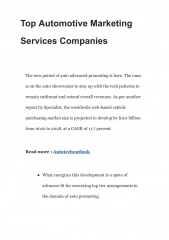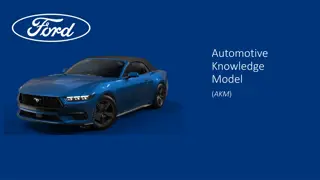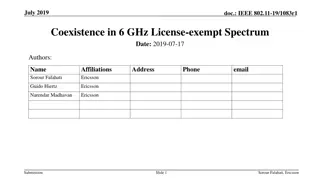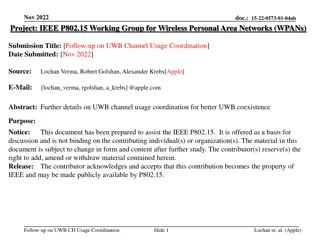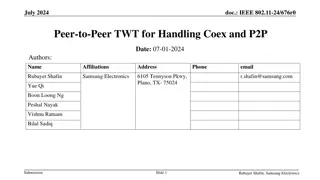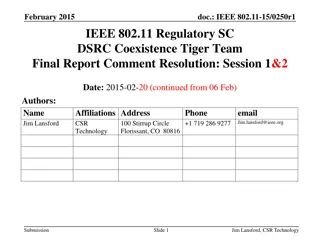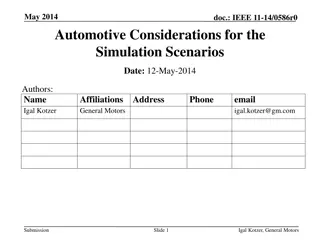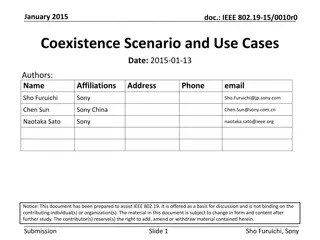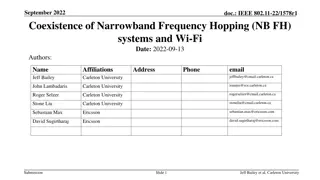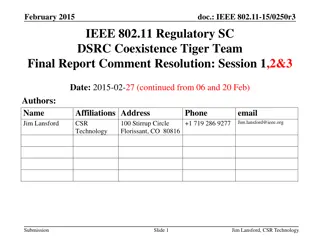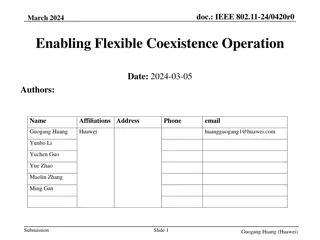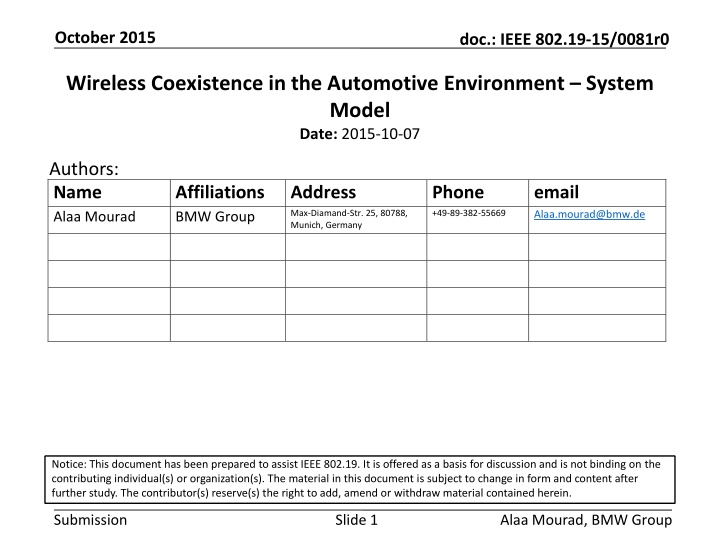
Wireless Coexistence in the Automotive Environment: IEEE 802.19-15/0081r0
Explore the system model and scenarios for wireless coexistence in the automotive domain, focusing on infotainment applications and wireless systems like WLAN, Bluetooth, and Kleer. Understand the challenges of coexistence in different scenarios and the current situation with multiple connectivity chips in luxury cars operating in the 2.4GHz band.
Download Presentation

Please find below an Image/Link to download the presentation.
The content on the website is provided AS IS for your information and personal use only. It may not be sold, licensed, or shared on other websites without obtaining consent from the author. If you encounter any issues during the download, it is possible that the publisher has removed the file from their server.
You are allowed to download the files provided on this website for personal or commercial use, subject to the condition that they are used lawfully. All files are the property of their respective owners.
The content on the website is provided AS IS for your information and personal use only. It may not be sold, licensed, or shared on other websites without obtaining consent from the author.
E N D
Presentation Transcript
October 2015 doc.: IEEE 802.19-15/0081r0 Wireless Coexistence in the Automotive Environment System Model Date: 2015-10-07 Authors: Name Alaa Mourad Affiliations BMW Group Address Phone +49-89-382-55669 email Alaa.mourad@bmw.de Max-Diamand-Str. 25, 80788, Munich, Germany Notice: This document has been prepared to assist IEEE 802.19. It is offered as a basis for discussion and is not binding on the contributing individual(s) or organization(s). The material in this document is subject to change in form and content after further study. The contributor(s) reserve(s) the right to add, amend or withdraw material contained herein. Submission Slide 1 Alaa Mourad, BMW Group
October 2015 doc.: IEEE 802.19-15/0081r0 Abstract This document describes the system model and the different scenarios for wireless coexistence in the automotive domain Submission Slide 2 Alaa Mourad, BMW Group
October 2015 doc.: IEEE 802.19-15/0081r0 Background The number of vehicles with connectivity services has been significantly increased in the recent years, and it is expected that the number will increase drastically in the coming years The main use of these systems is infotainment applications The used wireless systems in the vehicles in the ISM band (2.4GHz) are: 1. WLAN 2. Bluetooth, BLE in the future ? 3. Kleer Submission Slide 3 Alaa Mourad, BMW Group
October 2015 doc.: IEEE 802.19-15/0081r0 Kleer Kleer is a system used for high quality wireless audio transmission between portable audio devices [1] It delivers full CD-quality audio with transmission of 16-bit, 44.1KHz sampled stereo audio, Lossless codec Kleer manufacture claims good coexistence strategy compared to Bluetooth Dynamic frequency hopping is used Bandwidth: 3 MHz (official), however measurements show strong side lobes Sixteen channels in the 2.4GHz band (2.403GHz-2.478GHz) Submission Slide 4 Alaa Mourad, BMW Group
October 2015 doc.: IEEE 802.19-15/0081r0 Scenarios The worst case, when all the systems are active in the vehicle, should be considered with two distinguished cases: The interference from the surrounding environment is ignored The interference form the surrounding environment is considered The second scenario is more challenging due to the large impact of the external interferers. In this submission, the focus is on the first case Submission Slide 5 Alaa Mourad, BMW Group
October 2015 doc.: IEEE 802.19-15/0081r0 Current Situation The luxury cars have the following chips nowadays: Two WiFi chips Two Bluetooth chips Two kleer chips All the systems work in the 2.4GHz frequency band It is expected that theses systems will be available in the majority of the vehicles in the future Submission Slide 6 Alaa Mourad, BMW Group
October 2015 doc.: IEEE 802.19-15/0081r0 Current Situation WiFi: one chip is used as a hotspot, in order to provide connection to the internet (via cellular systems), second chip is used for WiFi direct applications (like Miracast) In order to guarantee the QoS, every chip should use different channel Bluetooth: it is mainly used for handsfree calling, audio streaming and transferring data (like contact book) from mobile phones to the vehicle head unit Kleer: It is used for audio streaming for RSE (rear seat entertainment), each audio stream needs a separate chip Channel Utilization? Submission Slide 7 Alaa Mourad, BMW Group
October 2015 doc.: IEEE 802.19-15/0081r0 Current Situation The supported Bluetooth profiles are hands free profile (HFP), which requires 700 Kbps and Advanced Audio Distribution Profile (A2DP) for music streaming which requires 700Kbps The WiFi access point data rate is limited with LTE (in general cellular network) supported speed, 50Mbps is an expected value Internet browsing Video streaming (depends on video quality) Apps for automotive (A4A) WiFi direct is used for Miracast, each device needs 15Mbps; and touch command, each device needs 15 Mbps Submission Slide 8 Alaa Mourad, BMW Group
October 2015 doc.: IEEE 802.19-15/0081r0 Current Situation Submission Slide 9 Alaa Mourad, BMW Group
October 2015 doc.: IEEE 802.19-15/0081r0 Worst case scenario The available bandwidth in the 2.4GHz band is 83.5 MHz, in the worst case scenario, all the systems in the vehicle are running simultaneously: Two WLAN connections with 2*20MHz (40MHz is optional in case of 802.11n) bandwidth Two Bluetooth master with 2*20MHz bandwidth Two kleer connections with 2*3MHz (practically 2*5MHz, sidelobes) In this scenario the needed bandwidth is: 40+40+6=86 MHz>83.5MHz In case of 11n with 40MHz bandwidth, only two WLAN connections can be supported in the whole band sidelobes plays an important role due to the short distances in the car Submission Slide 10 Alaa Mourad, BMW Group
October 2015 doc.: IEEE 802.19-15/0081r0 Channel Model The distances between the devices is very small in the vehicle due to the small volume, typical distances<2m Compared to indoor environment, different materials and smaller volume, glass penetration loss <2dB Wireless channel measurements inside the vehicle were performed by GM [2] in order to evaluate the channel characteristics Different positions in the car were considered The RMS channel delay spread is 22ns which is much smaller than typical values for indoor environment (40-600ns) Submission Slide 11 Alaa Mourad, BMW Group
October 2015 doc.: IEEE 802.19-15/0081r0 Channel Model The measurement results fit the following model: ? ? = ??? + ? with: L(d) is the total path loss Lm(d) is the mean path loss S is the shadowing with log normal distribution and zero mean The results are from [2] Submission Slide 12 Alaa Mourad, BMW Group
October 2015 doc.: IEEE 802.19-15/0081r0 Channel Model It is clear that the path loss is quite small in the vehicles compared to a typical indoor environment Therefore Power control plays an important role to reduce the interference to the surrounding environment It is clear that the wireless systems inside the vehicle is not power limited, it is more interference limited Submission Slide 13 Alaa Mourad, BMW Group
October 2015 doc.: IEEE 802.19-15/0081r0 Conclusion The system model was presented taking into account only the systems inside the vehicle It is clear that the density of the wireless devices is very high inside the car, and the bandwidth at the 2.4GHz ISM band is limited (only 83.5MHz is available), therefore the problem is quite challenging Wireless sensor network (BLE/ZigBee) will increase the problem Measurements should be done in order to check the performance of different systems taking into account different scenarios, for example how effective the Bluetooth AFH in such dense scenario? Performance metrics should be defined Submission Slide 14 Alaa Mourad, BMW Group
October 2015 doc.: IEEE 802.19-15/0081r0 References [1] Wireless Digital Audio Quality for Portable Audio Application, KLEER KLR0000-WP1-1.4, available at: http://ww1.microchip.com/downloads/en/DeviceDoc/Kleer_AudioQuality.pdf (last access: 24 March 2015), 2007b. [2] Extended Intra-Vehicle Channel Model , Igal Kotzer (General Motors), IEEE 11-14/0088r0. Submission Slide 15 Alaa Mourad, BMW Group

